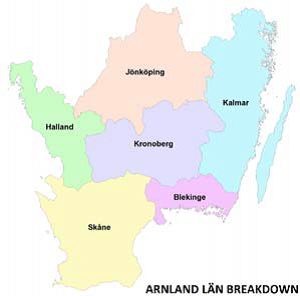Arnland Counties
Arnland is comprised of 6 Counties(län), that cover nearly 52,300 km2 with a population of 3,382,608 (2010), situated on the southern tip of the Scandinavian Peninsula. The geographic location is a strategically important one with proximity to the Baltic Approaches and to NATO nations, such as Denmark and Germany.
Contents
Halland County
Halland is situated in northwestern Arnland on the Baltic Approaches. The county covers a total area of about 5,800 km2. The county capital is Halmstad, which is a significant port city. This city was founded in the 12th century. The county has six municipalities.
Halland is a county rich in resources, of which forestry is one. About 53% of the area is spruce forests. The public sector is the largest employer in the county, with the Ringhals nuclear power station being an important component thereof. In addition, there are both paper industry and glass industries in the county.
The population of Halland is 389,484, with more people moving into than out of the county. The net inflow was about 800 last year.
Skåne County
Skåne is located in the southwest part of Arnland. The county covers an area of about 11,000 km2 and its capital is Alsstad, which is also the national capital of Arnland. The city was founded in the 12th century. The county has 33 municipalities.
The preeminent natural resource is agriculture, with 48% of the county being cultivated farm land. The public sector is the largest employer in the county, but the packaging industry is also significant.
The total population of Skåne is 1,144,366, and there are more people moving into the county than out. The inflow last year was about 6,700.
Kronoberg County
Kronoberg is a landlocked county in the middle of Arnland. Traditionally relatively wealthy with a long history of manufacturing, it has usually experienced low unemployment rates as a result. The county covers an area of about 8,500 km2, and the capital is Vaxsjo, which was founded in the 13th century.
The glass, metal, masonry, and paper industries are important export industries; in fact, the most preeminent in the country. There is also a significant information technology (IT) industry and considerable research—both important in maintaining the industrial manufacturing footprint in the county. A full 69% of the county is covered by forest, providing the foundation for the paper mill industry.
The total population of Kronoberg County is 183,940, with a net inflow of about 1,500 people.
Kalmar County
Kalmar is located on the east coast of Arnland and the county covers an area of about 11,700 km2. The coastline is long, with roughly 16,000 islands off the coast, and there are also numerous lakes. The renowned Linné University is situated in the county capital city of Kalmar. The city of Kalmar was founded in the 11th century.
It is also a relatively prosperous county, with about 6,000 registered businesses in the manufacturing and service sectors located within the county borders. Around 64% of the land is covered in forests. Forestry and tourism are the main industries in the county.
The total population of Kalmar is 333,536, with almost 1,000 in net inflow of people over the past year.
Blekinge County
Blekinge is the smallest county in Arnland, is located in the southern part of the country, and covers an area of nearly 3,000 km2. The county measures about 40 km from north to south, and 110 km from east to west. The county capital is Karlskrona, which also houses a large naval base currently being leased to Torrikan naval assets.
Fisheries and agriculture are preeminent industries in the county, and there is also a significant tourist industry. Blekinge also has a long industrial tradition, and the advent of new technologies has made it possible for industry in the county to modernize and maintain its position. Every fourth employee in Blekinge is currently employed in the industry.
The total population of Blekinge is 213,227, and the urban areas of the county have the highest population density in all of Arnland, with 52 inhabitants per km2.
Jönköping County
Jönköping is landlocked in the middle of northern Arnland. It covers a total area of 10,500 km2. There are more than 2,000 lakes in the county, which constitute 14% of its area. The capital city is Jönköping, and the county has existed since 1687.
The main industries are in manufacturing of wood, metal, and plastic products, creating an environment of employment opportunities. There is also a significant service industry in the county.
The total population of Jönköping is 419,092, with a population density of 22 inhabitants per km2.

